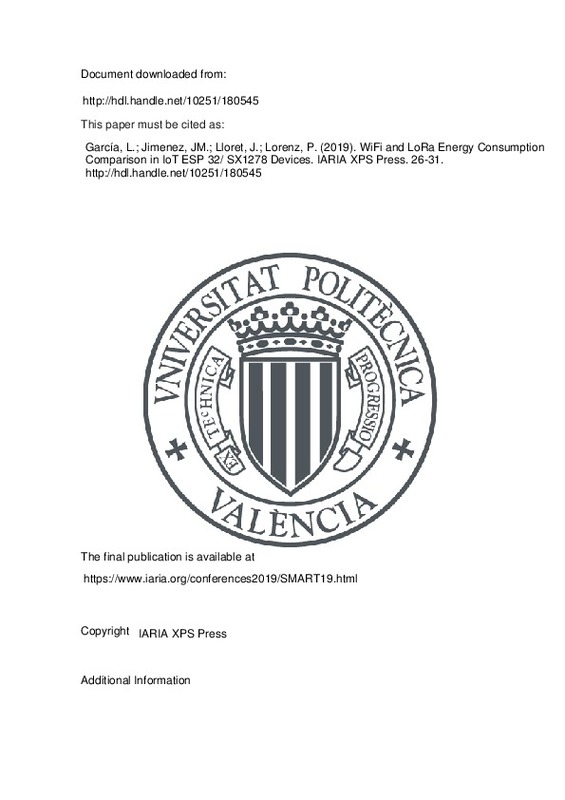JavaScript is disabled for your browser. Some features of this site may not work without it.
Buscar en RiuNet
Listar
Mi cuenta
Estadísticas
Ayuda RiuNet
Admin. UPV
WiFi and LoRa Energy Consumption Comparison in IoT ESP 32/ SX1278 Devices
Mostrar el registro sencillo del ítem
Ficheros en el ítem
| dc.contributor.author | García, Laura
|
es_ES |
| dc.contributor.author | Jimenez, Jose M.
|
es_ES |
| dc.contributor.author | Lloret, Jaime
|
es_ES |
| dc.contributor.author | Lorenz, Pascal
|
es_ES |
| dc.date.accessioned | 2022-02-07T08:28:52Z | |
| dc.date.available | 2022-02-07T08:28:52Z | |
| dc.date.issued | 2019-08-02 | es_ES |
| dc.identifier.isbn | 978-1-61208-730-6 | es_ES |
| dc.identifier.issn | 2308-3727 | es_ES |
| dc.identifier.uri | http://hdl.handle.net/10251/180545 | |
| dc.description.abstract | [EN] The use of Internet of Things (IoT) devices has spread through many different fields. Transport, health, and energy management of farming are some of the areas where IoT systems are being utilized. The selection of the wireless communication technology for the IoT system is paramount for its optimal performance. However, factors such as desired coverage or energy consumption must be considered for this selection. In this paper, several tests to determine the battery life that can be obtained after performing WiFi and LoRa Low Power Wide Area Networks (LPWAN) transmissions with a low-cost IoT device has been performed. With a 5 second transmission interval and default settings, similar results were obtained for both WiFi and LoRa. Furthermore, WiFi outperformed LoRa with the default settings and a 30 second transmission interval. Lastly, LoRa did outperform WiFi when the settings where changed so as the transmission power of LoRa was that of 10 dBm. | es_ES |
| dc.description.sponsorship | This work has been supported by European Union through the ERANETMED (Euromediterranean Cooperation through ERANET joint activities and beyond) project ERANETMED3-227 SMARTWATIR. | es_ES |
| dc.language | Inglés | es_ES |
| dc.publisher | IARIA XPS Press | es_ES |
| dc.relation.ispartof | SMART 2019, The Eighth International Conference on Smart Cities, Systems, Devices and Technologies | es_ES |
| dc.rights | Reserva de todos los derechos | es_ES |
| dc.subject | Energy consumption | es_ES |
| dc.subject | Battery life | es_ES |
| dc.subject | WiFi | es_ES |
| dc.subject | LoRa | es_ES |
| dc.subject | Transmission power | es_ES |
| dc.subject.classification | INGENIERIA TELEMATICA | es_ES |
| dc.title | WiFi and LoRa Energy Consumption Comparison in IoT ESP 32/ SX1278 Devices | es_ES |
| dc.type | Comunicación en congreso | es_ES |
| dc.type | Artículo | es_ES |
| dc.type | Capítulo de libro | es_ES |
| dc.relation.projectID | info:eu-repo/grantAgreement/EC//ERANETMED3-227 SMARTWATIR/ | es_ES |
| dc.rights.accessRights | Abierto | es_ES |
| dc.contributor.affiliation | Universitat Politècnica de València. Instituto de Investigación para la Gestión Integral de Zonas Costeras - Institut d'Investigació per a la Gestió Integral de Zones Costaneres | es_ES |
| dc.contributor.affiliation | Universitat Politècnica de València. Departamento de Comunicaciones - Departament de Comunicacions | es_ES |
| dc.description.bibliographicCitation | García, L.; Jimenez, JM.; Lloret, J.; Lorenz, P. (2019). WiFi and LoRa Energy Consumption Comparison in IoT ESP 32/ SX1278 Devices. IARIA XPS Press. 26-31. http://hdl.handle.net/10251/180545 | es_ES |
| dc.description.accrualMethod | S | es_ES |
| dc.relation.conferencename | The Eighth International Conference on Smart Cities, Systems, Devices and Technologies (SMART 2019) | es_ES |
| dc.relation.conferencedate | Julio 28-Agosto 02,2019 | es_ES |
| dc.relation.conferenceplace | Nice, France | es_ES |
| dc.relation.publisherversion | https://www.iaria.org/conferences2019/SMART19.html | es_ES |
| dc.description.upvformatpinicio | 26 | es_ES |
| dc.description.upvformatpfin | 31 | es_ES |
| dc.type.version | info:eu-repo/semantics/publishedVersion | es_ES |
| dc.relation.pasarela | S\412182 | es_ES |
| dc.contributor.funder | European Commission | es_ES |





![[Cerrado]](/themes/UPV/images/candado.png)

